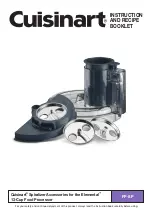
Pressure cask
Page 8 of 16
5.2
Replacing the gas bottle:
If you would like to refill the bottle with additional gas, or you simply want to remove the
bottle because the pressure is insufficient, first close the bottle at the valve (
4b
) of the
pressure relief valve. Ensure that the gas bottle and the exit port (
4b
) of the pressure relief
valve are closed! Now, remove the quick release (
2a
) from the male coupling (
1b
). The
hose, pressure relief valve, and gas bottle can now be removed from the vessel. A check
valve (
1
) constantly safeguards the pressure inside of the cask.
5.3
Maintenance/Inspection:
•
For safety reasons, the pressurized beverage cask must be inspected during regular
intervals. Here, compliance with all current national regulations pertaining to the safe
operation of pressure vessels is mandatory.
•
If the vessel was damaged, immediate inspection is necessary.
•
Maintenance/inspection is recommended at least once a year.
•
Visible changes such as cracks or other damage are not acceptable.
•
All threaded connections must be free of damage, must not show wear and tear and/or
contamination.
•
The pressure limiting valves must remain clean at all times, as sticky residue is
common when handling juices.
•
If purchasing a CO
2
bottle, a TÜV inspection is required every 10 years. Please
contact your gas specialist.
6
Range of application
6.1
Sweet cider with any desirable alcohol level
Use the pressurized beverage cask without connecting it to the gas bottle or attaching any
additional fittings. Thus, the cask can be used without adding any ancillary equipment.
No tools are required! Do not remove the blind plug, item 0.
•
If you prefer a clearer sweet cider with less alcohol content, it is recommended to
transfer the juice into another vessel after pressing and keep it there for 3 - 4 hours.
This will remove the cloudiness from the juice. Ensure to remove all spoiled fruit
prior to the pressing procedure.
•
After pressing, or once the must has settled, fill the beverage cask immediately with
the respective fruit juice.
•
Now, you can determine the alcohol content of the beverage. Once the cask has been
filled, immediately close it in order to obtain a sweet cider with less alcohol later on.
The longer you keep the cask open, the longer the fermentation will last, and the
alcohol level in the beverage will be increased. If the vessel is kept open for 3 to 4
days and subsequently closed, the result will be a much higher alcohol content. Ensure
that the juice will not ferment completely, otherwise, the beverage will not be left with
a residual sweetness, and additional fittings (see Application 3) will be required.
•
As soon as the cask is closed, pressure is generated inside of the vessel caused by the
fermentation until this process is stopped on its own. This way, you will always have a
Содержание 47014
Страница 1: ...Translation of original Operating Instructions For Pressure Cask Item No 47014 Issue August 2011...
Страница 12: ...Pressure cask Page 12 of 16 9 EU Conformity Declaration...
Страница 13: ...Pressure cask Page 13 of 16...
Страница 14: ...Pressure cask Page 14 of 16...
Страница 15: ...Pressure cask Page 15 of 16...


































